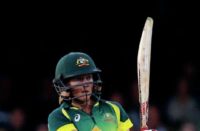Alison Mitchell looks ahead to the Aussie summer, and questions whether the fixture congestion is fair on players and fans
This column was supposed to be written from Perth as I started reporting for BT Sport on the first Test between Australia and South Africa at the WACA. Instead, it comes from my parents’ living room in Northamptonshire after suddenly finding out how a cricketer must feel when they’re picked for an exciting overseas tour only to be told a fortnight ahead of departure that they need an operation and can’t go.
I’ll now be watching BT Sport’s exciting new venture into cricket broadcasting from the sofa while I recover from major surgery following the inopportune collapse of my left lung a few weeks ago (mind you, I’m not sure there is an opportune time for a lung to collapse).
I’m hugely disappointed to be missing out on the action, but it does mean I’ll get a chance to watch Greg James on screen, providing a fresh face for BT’s coverage in the smart Stratford studio, alongside Michael Vaughan, Graeme Swann and former Australia captain Ricky Ponting. Kevin Pietersen will be offering insight from the ground, where he’s part of the commentary team with Channel Nine.
As this is The Cricket Paper not The Lancet, I’ll spare you the details of my op, but the plan is to make sure the surgery has been successful, then fly to Australia to join in the fun as soon as I am fully fit. I can’t wait.
Even before the fixture schedule for this Australian summer came out, it was being billed as one of their biggest cricket seasons ever. The domestic one-day cup started in October and has already been won by New South Wales.
The Sheffield Shield is underway, while the national team embarks on six Test matches; three against South Africa and three against Pakistan. Between the two series’ come three ODIs against New Zealand, whilst the men’s and women’s Big Bash Leagues start in December and run through until the final on January 28.
During this time, Australia will play five ODIs against Pakistan before nipping across to New Zealand for a three-match ODI series. The last match is on February 5, after which there are still three T20s to play against Sri Lanka back home.
Big doesn’t even quite describe it. If England coach Trevor Bayliss sounded a trifle peeved at having to play seven Tests in eight weeks before Christmas, such is the hectic nature of Australia’s fixture list that the last T20 International against Sri Lanka is scheduled to be played the day before Australia begins the first Test against India in Bangalore.
This cannot be right. The powers that be have naturally spun the positives out of it, in that it gives an opportunity to others, who will embrace the T20s with a certain freshness, instead of treating them like an add-on at the end of a long season. In fairness, Cricket Australia had to set their fixture list before they knew the dates of the India series, and this isn’t an unprecedented situation, but it is another example of the calendar being too crowded.
The fan loses out because they pay the same price for a ticket and want to see the best players play for their country, whatever the format. The multi-format players also lose out because they don’t get the opportunity to play many T20s and no player wants to gift someone the chance of performing so well they might ultimately take their place.
The only way administrators might start to get the message is if fans refuse to turn up, however that is unfair on the opposition who likely have a full-strength side and deserve to be marketed as so. Full internationals are not the place to be giving players a ‘go’. It is where the cream should come up against the cream.
England’s women start their tour of Sri Lanka next week needing to win just one of their three ODI Championship matches to seal their place at next summer’s 50-over World Cup. The first match on November 9 doesn’t count towards the Championship table, but the remaining three matches do, and England shouldn’t have any trouble securing their spot at their home tournament.
The last time England and Sri Lanka met in a bilateral series was 2010, when England had an unbeaten record. Their only encounter since then has been a startling victory for Sri Lanka in Mumbai at the World Cup 2013, when Eshani Kaushalya muscled a rapid half century to register her team’s first ever win over England.
Having witnessed that match first hand, as well as a victory over hosts India, it felt as if Sri Lanka’s women had really arrived on the international scene and were ready to start making an impact. Instead they have only won three of 30 ODIs since, and are in a rut of 14 defeats in a row.
Heather Knight’s side are missing both fast bowler Anya Shrubsole and left-arm spinner Sophie Ecclestone for this tour – Shrubsole is ruled out with the neck injury which forced her home from the West Indies, while 17-year-old Ecclestone has school commitments.
In Alex Hartley though, England have a left-arm spinner who has already started to look the part, with 13 wickets in five matches in her first full series in the West Indies. She was the leading wicket-taker in the series.
The West Indies tour was a little up and down, with England recovering from a horrible batting collapse in Jamaica to put in a solid performance to claim the final ODI and win the series 3-2. Openers Lauren Winfield and Tammy Beaumont continued to score well, along with Nat Sciver.
Going to Sri Lanka, a question mark remains over the number three spot, which was occupied by Georgia Elwiss for the first three matches in the Caribbean. After low scores in each, she dropped down the order yet still struggled. She could find herself replaced by Fran Wilson, who has a chance of playing her first ODI since 2010.
Australia have already qualified for the World Cup as confirmed winners of the ODI Championship. It was recently announced that the women’s World Cup qualifying tournament will take place in Colombo in February.
That event will feature the bottom four sides from the Championship (Sri Lanka are rooted to the bottom at the moment) along with Bangladesh, Ireland, Scotland, Papua New Guinea, Thailand and Zimbabwe.
There is still a huge gap in standard between the leading international women’s teams and those beneath, but the Championship is an excellent system of qualifying with no closed shop and no protected teams.
If only such a system and schedule could be adopted in the men’s game.
This piece originally featured in The Cricket Paper, November 4 2016
Subscribe to the digital edition of The Cricket Paper here















